

|
158.220 bytes |
Product Information |
Document ID: DDSE-42SVH9 |
Netfinity 3000 - Internal Drives, Expansion Bays, Drive Specifications and Types of Cables
Applicable to: World-Wide
Internal Drives
You can add drives to the server to increase storage capacity and to enable the server to read multiple types of media. Several types of drives are available, such as:
- Diskette
- Hard disk
- Rewritable optical disc
- Tape
Expansion Bays: Internal drives are installed in bays at the front and rear of the server. The bays are referred to as bay 1, bay 2, and so on.
Drive bays 1 through 4, at the front of the server, are contained in the upper drive bracket. Drive bays 5 and 6, at the rear of the server, are contained in the lower drive bracket.
|
Note |
The server comes with the following preinstalled drives:
- A 3.5-inch, 1.44 MB diskette drive in bay 4
- A 3.5-inch, SCSI hard disk drive in bay 6 (in some models)
- A 5.25-inch, CD-ROM drive in bay 1
The following illustration shows the locations of the bays in the server. This illustration shows the server front view, with the side panel removed.
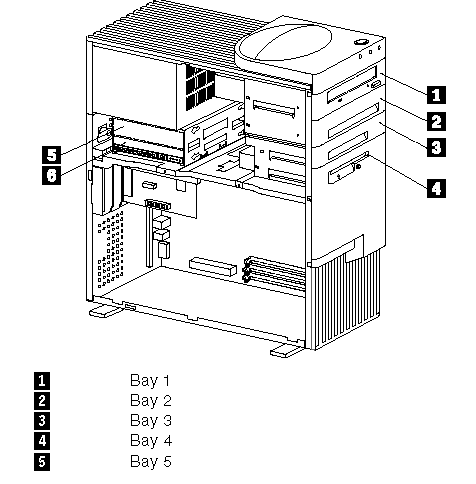
6 Bay 6
The following is a detailed description of the drive bay contents.
CD-ROM Drive: The server comes with an integrated drive electronics (IDE) CD-ROM drive.
Open Bays: The server's design accommodates 3.5-inch and 5.25-inch devices, such as hard disk, tape, and rewritable optical disk drives. The number and capacities of the hard disk drives vary by model.
For information on the supported types of drives and their installation, see "Drive Specifications", "Preinstallation Steps (All Bays)", and http://www.pc.ibm.com/us/compat/ on the World Wide Web.
Diskette Drive: The 3.5-inch, 1.44 MB (See Note 2 below) diskette drive uses 1 MB (unformatted) or 2 MB (unformatted) diskettes.
Note 2:
2 MB equals approximately 1 000 000 bytes; total user-accessible capacity may vary depending on operating environment.
Drive Specifications:
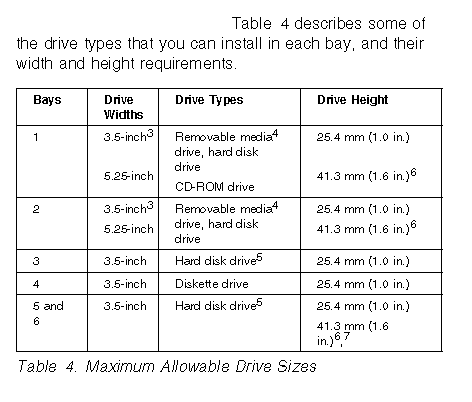
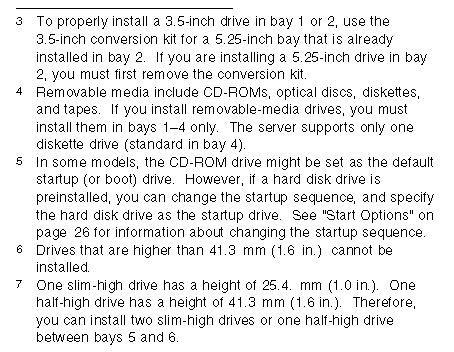
_______________________________________________________
Types of Cables:
The server uses cables to connect IDE and SCSI drives to the power supply, riser card, and system board. The diskette drive is also powered through a cable attached to the riser card. Each cable connector is designed to fit a corresponding drive connector. The following cables are provided:
- Four-wire power cables connect most drives to the power supply. At the ends of these cables are plastic connectors that attach to different drives; these connectors vary in size. Also, some power cables attach to the riser card.
- Flat signal cables, sometimes called ribbon cables, connect IDE drives to the riser card. There are two sizes of signal cables that come with the server.
- The wider signal cable attaches to the primary IDE connector on the back of the riser card.
- The narrower signal cable attaches to the diskette drive and to the diskette drive connector on the back of the riser card.
- A flat SCSI signal cable for connecting devices to the SCSI adapter.
Since the server is equipped with an UltraSCSI adapter, it has a ribbon cable that is connected to the internal SCSI hard disk drive. One end of this cable is connected to the 68-pin, internal SCSI connector on the SCSI adapter. The other end of the SCSI cable has a terminator. This cable provides four connectors for attaching other internal SCSI devices.
For more information about SCSI devices, see "SCSI Drives".
|
Note |
The diskette, IDE CD-ROM, and other IDE device connectors are on the back of the riser card. When you are installing optional drives, refer to the following illustration for the location of the appropriate connectors.
|
Note |
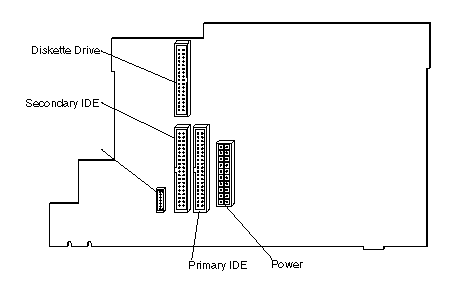
The following illustration shows the connectors on the riser card.
|
Notes |
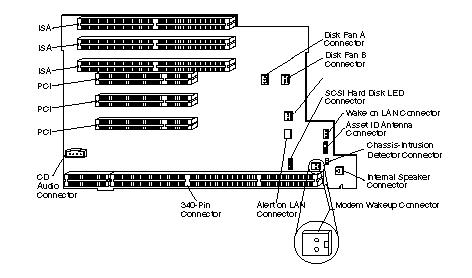
The following are some important points to remember when connecting power and signal cables to internal drives:
- The diskette drive, hard disk drive (if applicable), and CD-ROM drive that are preinstalled in the server come with power and signal cables attached. The CD-ROM drive is attached to the primary IDE connector on the back of the riser card. If you replace any drives, it is important to remember which cable is attached to which drive.
- When you install a drive, ensure that the connector at the end of the signal cable is connected to the system board.
- The CD-ROM drive and the diskette drive are the only IDE devices that come with the server. You can install another IDE device, such as a CD-ROM drive or tape drive; however, IDE hard disk drives are not supported.
- If two or more IDE devices are used on a single cable, one must be designated as the primary or master device and all others as secondary or subordinate devices; otherwise, some of the IDE devices might not be recognized by the system.
The primary or secondary designation is determined by switch or jumper settings on each IDE device.
In this server, the IDE CD-ROM drive is the primary device. If you install a second IDE device, it must be the secondary device.
- You can install one diskette drive only.
- If you plan to attach an internal SCSI drive, connect it to one of the available connectors on the internal SCSI cable.
|
Note |
If you plan to attach an external SCSI drive, see "External Options" for additional information.
For help in selecting drives, cables, and other options for the server, do one of the following:
- Within the United States, call 1-800-IBM-2YOU (1-800-426-2968), your IBM reseller, or your IBM marketing representative.
- Within Canada, call 1-800-565-3344 or 1-800-465-7999.
- Outside the United States and Canada, contact your IBM reseller or IBM marketing representative.
|
Search Keywords |
| |
|
Document Category |
Diagrams | |
|
Date Created |
03-12-98 | |
|
Last Updated |
03-12-98 | |
|
Revision Date |
03-12-99 | |
|
Brand |
IBM PC Server | |
|
Product Family |
Netfinity 3000 | |
|
Machine Type |
8476 | |
|
Model |
ALL | |
|
TypeModel |
| |
|
Retain Tip (if applicable) |
| |
|
Reverse Doclinks |